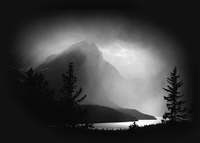090831 Cho Oyu Expedition
"I drink, therefore I am"
We have finally made it to Zangmu, Tibet. This is looking to be a
great wee trip, with 4 Brazilians, 3 Sherpas from Pangboche, 3
Maltese, a Guatamalan, a Brit and a cook from Kumjung.
Tomorrow we have trekking from Nyalam.
The bus ride from Kathmandu was broken in three places. At each of which we changed buses trekking past the obstacle to a transport already stranded on the other side. The first break was caused by a funeral. The man had been run down by a lorry the day before, the next two where monsoon flash floods had washed the road away. The last two are normal for this time of year. The five hour journey stretched towards twelve, and in the waiting hours the team conversation drifted aimlessly from the dangers of acute moountain sickness to alcohol abuse (though I still do not understand why we call drinking "alcohol abuse"; is there any other reasonable use for alcohol?) By the time our fourth transport reached Kodari we had sketched out a rational for drink climbing. It goes something like this:
A NEW PROPOSAL FOR REDUCING THE RISK OF DEVELOPING ACUTE MOUNTAIN SICKENESS.
It has been frequently noted that super-fit marathon runners do poorly at high altitude. They suffer more than most from AMS (Acute Mountain Sickness). This is possibly caused by being strong enough to climb high faster than their body will acclimatise; by contrast unfit climbers will be too weak to get themselves into trouble. Although I had noticed this anecdotally, in statistically insignifcant numbers, team member Dr Greg Attard (an emergency physician of Malta) said that he'd seen research papers attesting to this result. This observation can be expressed as follows, Athletic Prowess is proportional to the risk of AMS;
AP ~ rAMS
Where AP is Athletic Prowess,
"~" means "proportional to" and
rAMS is risk of developing AMS, and both terms are theoretically capable of being expressed as positive real numbers.
This is Attard's Attestation.
It will be immediately obvious that this direct relationship should be avoidable by the rational expedient of climbing more slowly, but this route to avoiding AMS seems to be difficult for those athletes. It has been claimed that highly trained runners have difficulty adjusting the strenously learned marathon runners pace to the more leisurely mountaineers pace. However, to quote Dr Attard on this possibilty "To slow down is not rocket science" which in turn raises the question of IQ (Intelligence Quotient). Team member Mark Cremona (a water engineer of Malta) notes that if it is not "rocket science" to slow down, the implication is that the cohort of marathon runners attempting high mountains are blessed with unusually low IQ, the proof of which is that they took up marathon running in the first place.
This is expressed as, IQ is inversely proportional to the risk of AMS:
1/IQ ~ rAMS
This is Cremona's Corollary. The Attestation and it's Corollary have been combined into a single expression by team member Robert Gatt (an Information Technologist, apparently also of Malta) into Robert's Rule, where the ratio of Athletic Prowess to IQ is proportional to the risk of AMS:
AP/IQ ~ rAMS
We will return to Robert' Rule later, but first we need to look at the affect of acohol on rAMS. It is usually said that acohol has a negative effect on climbers, while increasing the risk of AMS. We will show this fear to be misplaced.
It can be seen that AC (Alcohol Consumption) reduces both the numerator and denominator of the left hand side of Robert's Rule. A static or constant rAMS will be maintained if the rate of change of the two terms is proportional for a given quantity of acohol. This is easily demonstrated thus;
When zero acohol has been consumed the quantity of alcolhol consumed is "QZ". Now consider (or consume) a quantity of alcohol "QC" such that a state of comatose inebriation is attained. At QZ, AP is 100% of normal, as is IQ. At QC, the inabilty to consciously move reduces AP to 0%. While the inabilty to make any meaningful converation effectively reduces IQ to 0% too. So we can more or less safely say that
(AP+QZ)/(IQ+QZ) = (AP+QC)/IQ+QC) and in both cases rAMS will be constant.
Robert's Rule is not violated by AC for any consumed quantity between QZ and QC.
So we can deduce that the consumtion of alcohol does not increase the risk of AMS for the climber. This will come as welcome news for many of the climbing fraternity. However, I believe I have even better news for these unfortunate people.
Returning to Robert's Rule
AP/IQ ~ rAMS
It will be seen that to decrease rAMS, AP must be reduced in relation to IQ. But IQ has proved tantalisingly difficult to raise for marathon runners.
However we propose that a bounce back effect can be used in the period before exposure to high altitude. It works like this;
Regular AC reduces both AP and IQ, but if "AC training" is substituted for "training runs" and this is done methodically, the result should be a nicely reduced AP over time, with a more or less full recovery of IQ after the "AC training" sessions.
In the following expressions,
ACT is Alcohol Consumption Training,
ACR is Alcohol Consumption Recovery.
"->" means "leads to" and
"<" means less than
(1) represents the initial value
(2) represents the changed value
AP(1)/IQ(1)+ACT -> AP(2)/IQ(2)
where AP(1) is larger than AP(2), and
IQ(1) is larger than IQ(2)
AP(2)/IQ(2)+ACR -> AP(2)/IQ(1)
but AP(2)/IQ(1) < AP(2)/IQ(2)
therefor rAMS is reduced.Our team has not yet tested out this proposed method of reducing the risk of AMS, but we believe it has great potential.
Contributors;
Dr G Attard
Mr M Cremona
Mr R Gatt
Mr V Saunders
===============================END=================================================copyright copyright Victor Saunders
31 August 2009

